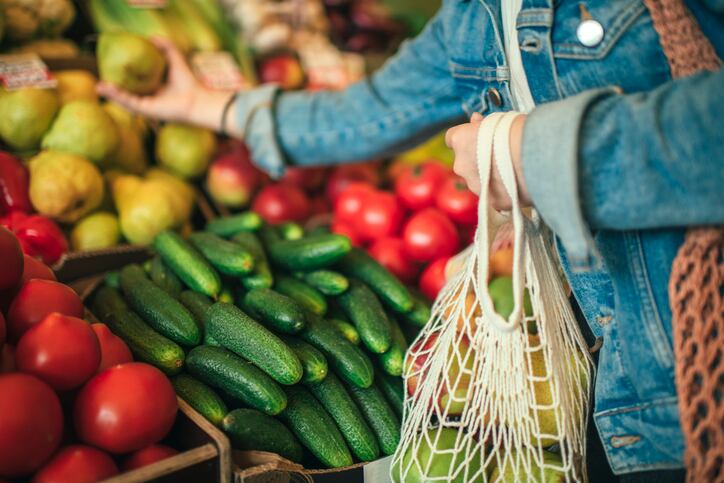While many grocery shoppers are pulling back on nonessentials or trading down to private label to stay within their budget amid stubborn inflation, one place where many consumers – especially Gen Z – are willing to pay more is for organic, according to new research commissioned by the Organic Trade Association and conducted by Euromonitor.
The survey of 2,522 Americans found Gen Z consumers, across economic levels, prioritize buying organic, while Millennials who make more than $100,000 annually also prioritize the certification. About half of each group are willing to pay a higher price for organic compared to products without the same claim, according to the survey.
Even though older demographics may worry about the price of organic, the survey found 45% of Gen X and 30% of Baby Boomers are willing to pay more for USDA certified organic products versus their conventional counterparts.
Younger consumers’ willingness to spend more on organic underscores the high value and trust they place in the label, while the categories in which they prioritize those purchases can serve as a roadmap for innovation and where the industry is going, said Matthew Dillon, co-CEO of the Organic Trade Association.
For example, he noted that baby food “is a really bright spot” for organic with 93% of consumers in the category reporting buying at least “some” organic options. Likewise, he said he sees significant opportunity for organic protein that is portable, convenient or snackable.
“Consumers want more of those products on the shelf,” he said.
What is driving organic sales?
The USDA Organic certification is multifaceted, but for many years stakeholders have focused primarily on its environmental benefits in storytelling – but the survey suggests that may not be the most impactful talking point.
“I always want to promote what I would call the altruistic benefits of organic. It’s better for farm workers. It’s better for farm families, reducing exposure to pesticides. It’s better for biodiversity, for soil health, for climate. But that is not where the consumers are,” said Dillon.
Rather, he said, “the consumers are still very much focused on what’s good for them. They want the absence of growth hormones, absence of pesticides, absence of antibiotics, and they want more nutritious food in general.”
According to the survey, 44% of respondents said the organic claim is important or very important to them – which is slightly less than the 45% who said the same for non-GMO claims, and significantly lower than the 54% who highlighted ‘no added hormones’ as important or very important and the 53% who said ‘raised without antibiotics’ is important or very important to them.
“The one spot where that is starting to shift is, again, in the younger consumer,” added Dillon, noting that while younger shoppers are still focused on how their purchases impact their own wellbeing, the wellbeing of the planet is an emerging area of interest for them.
“My advice to marketers is you have to meet consumers where they are, but you also have to be playing to where they may go. And for the younger generation, there are some strong signals that they are going to care more about those altruistic, environmental and other benefits,” he said.
Marketing strategies to better leverage organic’s full value
To better engage younger consumers, further maximize the impact of the organic seal and drive sales, Dillon urges industry stakeholders to “refresh” how they talk about organic to better engage younger consumers.
“We have been around as a federal seal since 2002 and there is both stability and trust in that multi-decade trajectory, and there is a risk of being seen as that ‘boring old thing,’” said Dillon.
“The organic sector has sometimes perpetuated myths that don’t really serve us in the long run, like that organic is farming like Grandma and Grandpa use to. And at OTA, with our members, you can actually learn about how organic is an innovative approach to agriculture and food,” said Dillon.
He suggested companies use QR codes, social media and other storytelling tools to share the full value of organic.
Another way the industry can keep the seal “fresh” for younger consumers is to ensure organic regulations meet their expectations – such as including higher standards for animal welfare, which is a battle OTA fought and won to update, said Dillon.
Younger consumers also want measurable proof that organic improves the health of the planet, said Dillon. As such, he said, the organic standards may need to include more reporting requirements.
OTA wants to modernize the organic seal
Simultaneously, OTA is lobbying Congress for the ability to callout within the seal the single-attribute claims that consumers most care about which are included in the organic certification, such as non-GMO or made without antibiotics.
“Right now, a brand can’t say ‘no antibiotics’ around the seal, or ‘no growth hormones’ or ‘non-GMO.’ The USDA does not allow that in the statute for Organic. We are starting to lobby Congress to change that because those are statutorily-approved talking points at the retail level and elsewhere. We want to be able to put that on pack and simplify things for producers,” Dillon said.
Videograph, editing and production by Caroline Rude


